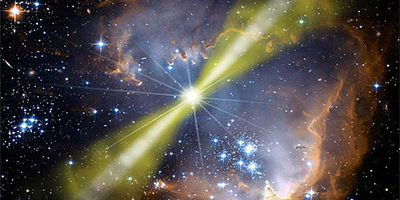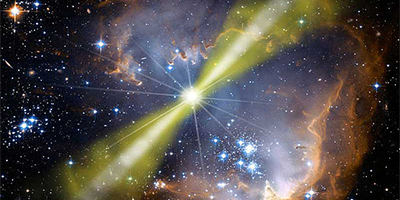Gamma-Ray Bursts Guide Search for Gravitational Waves
Gravitational waves (GWs)—ripples in spacetime predicted by Einstein—have never been directly observed. Detection is complicated by the fact that GWs would have an extremely small effect on detectors and that their most promising sources (such as black holes or neutron-star binaries) are so far away from Earth that the amplitude of the waves would be extremely small by the time they reach us.
To tackle this challenge, researchers have developed ultrasensitive laser-based interferometers that could detect the passage of a GW by measuring tiny length differences between two giant (kilometer-scale) perpendicular interferometer arms. Since simultaneous measurements from several detectors in far-away locations is the best way to rule out false signals, two large international collaborations—the Laser Interferometer Gravitational-Wave Observatory (LIGO), with observatories in Louisiana and Washington, and Virgo, running an interferometer in Italy—have teamed up for a search. The researchers synchronized their searches with the arrival time of gamma-ray bursts (GRBs), which are associated with the same astronomical events thought to release gravitational waves. GRB data were provided by the InterPlanetary Network of satellites and other spacecraft.
Starting in 2005, the two teams spent five years studying GRBs—the most extensive GRB-based search to date, with a twofold improvement in signal statistics compared to previous searches. But within the sensitivity of their detectors, they saw no gravitational waves: according to their data, the observed GRB sources were too distant to generate detectable GWs. But the analysis of their findings leaves room for hope: with GW sources at comparable distances, planned improvements to the LIGO and Virgo detectors will give the researchers a chance of spotting the elusive waves when the collaborations begin taking data again in 2015. – Matteo Rini





